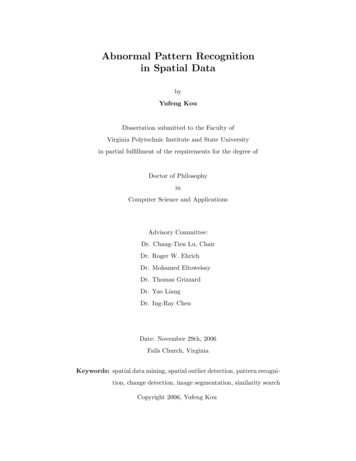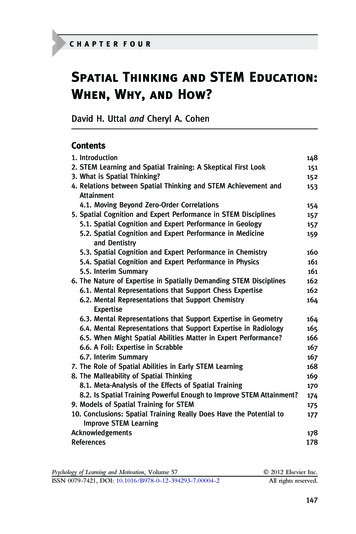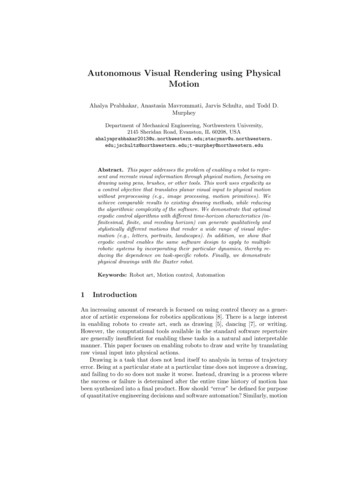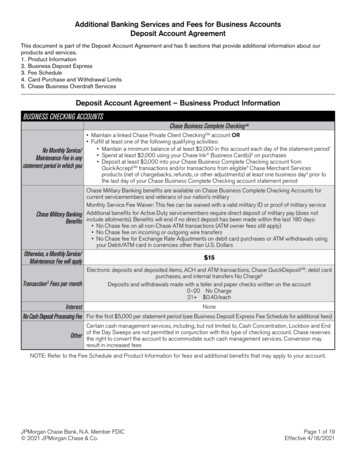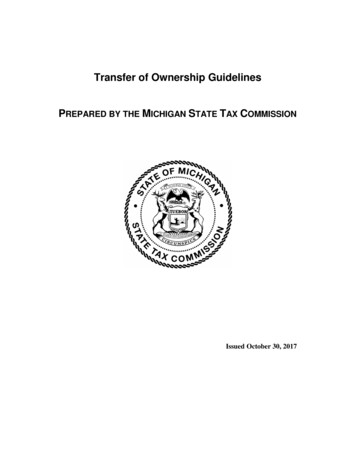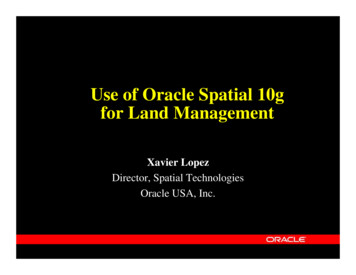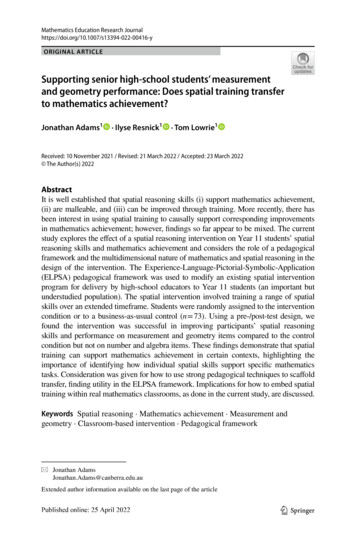
Transcription
Mathematics Education Research RIGINAL ARTICLESupporting senior high‑school students’ measurementand geometry performance: Does spatial training transferto mathematics achievement?Jonathan Adams1· Ilyse Resnick1· Tom Lowrie1Received: 10 November 2021 / Revised: 21 March 2022 / Accepted: 23 March 2022 The Author(s) 2022AbstractIt is well established that spatial reasoning skills (i) support mathematics achievement,(ii) are malleable, and (iii) can be improved through training. More recently, there hasbeen interest in using spatial training to causally support corresponding improvementsin mathematics achievement; however, findings so far appear to be mixed. The currentstudy explores the effect of a spatial reasoning intervention on Year 11 students’ spatialreasoning skills and mathematics achievement and considers the role of a pedagogicalframework and the multidimensional nature of mathematics and spatial reasoning in thedesign of the intervention. The (ELPSA) pedagogical framework was used to modify an existing spatial interventionprogram for delivery by high-school educators to Year 11 students (an important butunderstudied population). The spatial intervention involved training a range of spatialskills over an extended timeframe. Students were randomly assigned to the interventioncondition or to a business-as-usual control (n 73). Using a pre-/post-test design, wefound the intervention was successful in improving participants’ spatial reasoningskills and performance on measurement and geometry items compared to the controlcondition but not on number and algebra items. These findings demonstrate that spatialtraining can support mathematics achievement in certain contexts, highlighting theimportance of identifying how individual spatial skills support specific mathematicstasks. Consideration was given for how to use strong pedagogical techniques to scaffoldtransfer, finding utility in the ELPSA framework. Implications for how to embed spatialtraining within real mathematics classrooms, as done in the current study, are discussed.Keywords Spatial reasoning · Mathematics achievement · Measurement andgeometry · Classroom-based intervention · Pedagogical framework* Jonathan AdamsJonathan.Adams@canberra.edu.auExtended author information available on the last page of the article13Vol.:(0123456789)
J. Adams et al.IntroductionIt is widely understood that spatial reasoning supports mathematical achievement (e.g.Landy & Goldstone, 2010; Mix et al., 2016; Thompson et al., 2013). This connectionis present across different ages and across different mathematical and spatial tasks (e.g.Burnett et al., 1979; Delgado & Prieto, 2004; Lubinski & Benbow, 1992; Nuttall et al.,2005). Spatial skills are highly predictive of the pursuit of STEM careers and overallsuccess in STEM subjects, particularly mathematics (Wai et al., 2009). More recently,there is a growing body of evidence demonstrating that teaching spatial skills causallyimproves mathematics achievement (e.g., Cheng & Mix, 2014; Lowrie et al., 2017,2018a; Sorby et al., 2013; Sorby & Veurink, 2019). Studies are varied, however, withsome showing broad transfer (e.g. Lowrie et al., 2017, 2019), some finding narrow transfer (Cheng & Mix, 2014; Gilligan et al., 2020), and still, others finding no evidence ofimproved mathematics achievement in response to spatial training (e.g. Hawes et al.,2015). In the following sections, we account for such mixed findings by considering (1)the multidimensional nature of both spatial reasoning and mathematics and (2) the roleand nature of pedagogical frameworks, particularly the experience-language-pictorialsymbolic-application (ELPSA) framework (Lowrie et al., 2018b) in supporting spatial learning. Building from this research, the current study examines the efficacy of a spatial reasoning intervention on Year 11 students’ spatial reasoning skills and mathematics achievement.Literature reviewDefining spatial reasoning and mathematicsSpatial reasoning and mathematics are both complex and multidimensionalinvolving a wide range of interconnected skills. Mathematics is a broad area ofstudy, encapsulating a range of different strands, such as number, algebra, measurement, and geometry (Australian Curriculum, Assessment and ReportingAuthority (ACARA), 2010). Although many of these strands are interconnected,the types of skills required to solve any given problem will vary depending onthe topic. For example, interpreting a diagram representing geometric information requires different underlying skills than those used in solving an algebraicequation (Geary et al., 2015). The same problem may also require different oradditional skills depending on the way the problem is framed. For example, Duffyet al. (2020) found that the ability to apply the necessary algebraic skills was notsufficient for participants to solve mathematical tasks presented as word problems. As well as procedural fluency, word problems often require additional literacy and interpretation skills to arrive at a correct solution.Similarly, spatial reasoning is comprised of many different, yet interrelated,individual spatial skills (Buckley et al., 2018; Newcombe & Shipley, 2015).For example, being able to imagine an object rotating is a separable skill frombeing able to imagine someone else’s perspective (Hegarty & Waller, 2004). The13
Supporting senior high‑school students’ measurement and relationship between individual spatial skills is complex, and consequently, thefield has not reached an agreed upon framework for identifying and characterising spatial reasoning skills (e.g. Carroll, 1993; Linn & Petersen, 1985; Miyakeet al., 2001; Newcombe & Shipley, 2015). Indeed, Buckley et al. (2018) suggestthere are likely many more unique spatial reasoning skills not currently includedin existing frameworks.One spatial reasoning framework particularly relevant for considering how toconnect spatial skills with classroom practice is Ramful et al.’s (2017) because theyidentify three spatial reasoning constructs that are closely aligned with activitiesdescribed in mathematics curricula, namely mental rotation, spatial orientation, andspatial visualisation. Mental rotation relates to imagining the rotation of an object intwo- or three-dimensional space. Spatial orientation involves imagining how a scenemight appear from a different perspective. Mental rotation and spatial orientation arewell defined within the literature and have been shown to be separable spatial skills(Hegarty & Waller, 2004; Kozhevnikov & Hegarty, 2001). Spatial visualisation,under Ramful et al.’s (2017) framework, is a broader construct, encompassing challenging tasks that require reasoning about changing spatial relationships within andbetween objects over time. This framework has been used in several studies exploring the causal relationship between spatial reasoning interventions and improvements in mathematics (e.g. Lowrie et al., 2017, 2019).The effect of spatial training on mathematics achievementMany studies have shown that spatial reasoning skills are malleable and can beimproved through training in a wide range of populations and types of training (seeUttal et al., 2013 for a meta-analytic review). Importantly, the training of spatialskills can lead to corresponding improvements in mathematics achievement (e.g.Lowrie et al., 2017, 2018a; Sorby et al., 2013; Sorby & Veurink, 2019); howeverthe extent to which this occurs varies according to the age of participants, the designof the intervention program, and the extent to which the mathematical measures arealigned to the skills trained (Hawes et al., 2022).Approaches demonstrating limited or narrow transfer of spatial training to mathematics achievement tend to be narrow in scope and short in duration (e.g. Cheng &Mix, 2014; Hawes et al., 2015). By contrast, the most promising approaches, demonstrating broad transfer of spatial training to general mathematics achievement, haveinvolved training a wide range of spatial skills over an extended timeframe alongside regular mathematics learning (e.g. Hawes et al., 2017; Lowrie et al., 2019). Forexample, Sorby et al. (2013) delivered a 15-week spatial reasoning intervention thatincluded mental rotation, perspective taking (referred to in the current study as spatial orientation), and a range of complex spatial visualisation skills. The study foundthe spatial reasoning intervention led to improvements in students’ calculus grades.Continuation of the program in future years also led to improved grades across arange of undergraduate subjects and higher retention rates throughout the engineering program (Sorby et al., 2018).13
J. Adams et al.This is certainly promising; however, Sorby et al.’s (2013, 2018) work is focusedon first-year engineering students, who represent a biased population. Since thesestudents have gained entry into an undergraduate engineering program, they arelikely to have significantly higher mathematics skills than the general population.This high level of mathematical competence may have supported the transfer of spatial training to mathematics in a way that may not be representative of the generalpopulation. For example, although students’ interpretation and understanding ofsome types of mathematical problems can benefit from spatial training, it does notlead to overall improved performance when students lack the requisite proceduralmathematics skills (Duffy et al., 2020).As a result, to engage with programs such as Sorby et al. (2013, 2018), studentswithout a strong mathematical or spatial background may require additional scaffolding and support to meaningfully engage with the program. Here, we detail ELPSApedagogical framework (Lowrie et al. 2018b) as a way to provide this scaffolding.As spatial reasoning is the foundation for two of the stages (language and symbolic),it provides the opportunity for explicit links to be made between spatial reasoningand mathematics. In addition, educators administering a spatial intervention mayalso benefit from having pedagogical framing (Lowrie et al., 2018a) because secondary STEM educators are likely to have relatively higher spatial skills (Atit et al.,2018) and subsequently may not have intuitions around the hurdles low-spatial reasoning students may encounter.The ELPSA pedagogical frameworkThe ELPSA framework has been designed to support planning, teaching, andevaluation of learning in mathematics classrooms (Lowrie et al., 2018b). Based onTable 1 Stages of the ELPSA framework adapted from Lowrie et al., (2018b)StagesPrinciplesExperienceEvoke out-of-school experience to build on understandingReinforcing existing understandings to new conceptsFor new concepts, provide physical experiences where possibleLanguageReinforce mathematics terminology throughout the lessonFoster conversations that link experiences with language. Build bridgesbetween experience and languageEncourage students’ own language while modelling precise terminologyPictorialIncludes concrete manipulatives, external representations, and students’encoded understandingsEnsure multiple representations are provided including non-prototypicalrepresentationsProgressively model effective pictorial heuristicsSymbolicIntroduce symbolic expressions alongside pictorial representationsEncourage multiple appropriate symbolic representationsModel fluency and flexibility with efficient symbolic representationsApplicationApply symbolic reasoning to real-life situationsApply symbolic reasoning to related mathematics conceptsConsider the application of the mathematics concepts outside the classroom13
Supporting senior high‑school students’ measurement and constructivist learning theory (Liebeck, 1984; Vygotsky, 1978; Wenger, 1999),ELPSA promotes student learning by guiding students through five distinct stages(see Table 1 for an overview) that introduce new ideas through tangible, concrete experiences, and scaffolding students towards applying their understandingin more novel, abstract contexts. The ELPSA framework is particularly effective for supporting learning across all ages and skill levels because it implicitlyrequires the educator to consider the differential pedagogical needs of the classwhen delivering learning materials. Since heavy importance is placed on the pastexperiences of students when considering how to introduce new ideas, the kindsof activities incorporated into each stage will vary depending on the age and skilllevel of the students.The ELPSA framework has been used previously to assist students’ spatiallearning in both elementary and high-school contexts (Lowrie et al., 2018a, 2019).Many existing spatial training studies have researchers administer the interventiondirectly to students. By contrast, these studies had teachers incorporate spatial training within their regular classroom practice. In both cases, teachers were providedwith professional learning around the ELPSA framework, and lessons were designedto move students through each stage. This approach maintained experimental fidelity while still allowing teachers to adapt the lessons to meet the pedagogical needsof their particular students. In both studies, the interventions led to improvements instudents’ spatial reasoning skills.The ELPSA framework is also an effective tool for analysing existing programsand identifying their appropriateness for a given population. Take, for example,Sorby et al.’s (2013, 2018) highly successful spatial reasoning intervention program,which was tailored for undergraduate engineering students who likely already havean extensive background in mathematics. As is appropriate for such a group, concepts and definitions are introduced only formally (e.g. presented beside diagrams);students do not engage in lessons that explicitly target language learning, moving on to the pictorial and symbolic stages, with few opportunities to articulatetheir understandings in their own words. This is justified, given these studentslikely have some prior knowledge of mathematical concepts as well as experience in mathematics classes where terms have been introduced in a similarfashion.Although such an approach is appropriate for undergraduate engineering students, the ELPSA framework suggests that younger populations and individualswith less experience with mathematics may require more opportunities to developexperiences with these basic skills and concepts as well as language to support morecomplex learning. Specifically, modifications using the ELPSA framework mightfocus on introducing concepts with more concrete experiences, which explicitlyrequire students to develop and use spatial language.Sorby et al.’s (2013, 2018) program provides strong scaffolding for representingspatial concepts pictorially, using diagrams to illustrate key ideas and providingstep-by-step guidance through worked examples. Symbolic representations areintroduced and supported pictorially, and work-sample exercises give students theopportunities to apply their spatial understanding to a range of problems. Nevertheless, younger and less mathematically experienced populations may benefit13
J. Adams et al.Table 2 Analysis of Sorby et al. (2013, 2018) program using the ELPSA frameworkELPSA elementSorby et al. (2013, 2018) programExperienceBuilt on students’ past learning of mathematicsAssumption of familiarity with mathematical and spatial languageLanguageDefinitions of key terms provided next to diagramsLimited opportunities for students to articulate understandingPictorialKey ideas illustrated through diagramsStep-by-step guidance through worked examplesRelies on the ability to interpret 2-D representations of 3-D objectsSymbolicIntroduced clearly alongside pictorial representationsApplicationFollow naturally from prior learningExplore a range of contextsfrom more explicit scaffolding to support students in understanding pictorial andsymbolic representations. A summary of this analysis is provided in Table 2.Present studyThe present study aims to explore the effect of a spatial reasoning intervention onYear 11 students’ spatial reasoning skills and mathematics achievement. This isan important population to study since for many students the last 2 years of highschool are the final opportunity to engage in formal mathematical study. Consequently, the experiences they have at this stage of schooling will shape theirbeliefs and attitudes towards mathematics for the rest of their lives. Due to thesuccess of Sorby et al.’s (2013, 2018) program in improving the spatial reasoningand mathematical achievement of students who were only slightly older, the present study modifies the program for use with this new population.Recall that both mathematics and spatial reasoning involve multidimensionalconstructs. We considered the multi-dimensionality of spatial reasoning by training several spatial skills as well as using a composite spatial reasoning score thatincludes three spatial reasoning constructs identified by Lowrie and colleagues(Lowrie et al., 2017; Ramful et al., 2017). We considered the multidimensionalityof mathematics by examining the effects of the intervention on two mathematicsstrands identified by the Australian Curriculum: Mathematics (ACARA, 2010)—Number and Algebra, and Measurement and Geometry. The ELPSA framework(Lowrie et al., 2018b) is used to guide these modifications to make the existingprogram accessible to this younger group of participants who likely do not havethe same background and skills in mathematics.Distinct from existing research demonstrating transfer between spatial training and mathematics understanding (e.g. Cheng & Mix, 2014; Gilligan et al.,2020), the current study maintains a high level of ecological validity by developing intervention materials to be delivered by classroom teachers during regularmathematics lessons.13
Supporting senior high‑school students’ measurement and MethodsParticipants and settingParticipants for the study were Year 11 students from two senior secondaryschools in a large Australian city with middle-to-high socioeconomic status (SES;ACARA, 2010). All participants were enrolled in an elementary mathematicscourse focusing on practical applications of mathematics such as financial arithmetic, statistics, measurement, and linear relationships. The schools encouragestudents who are low achieving in mathematics to take this more accessible, noncalculus-based unit, whereas students who are high achieving in mathematics arestrongly encouraged to take more difficult calculus-based courses. Consequently,many students enrolling in this unit may not have previously experienced success in mathematics. All students enrolled in the course and their parents wereprovided with information and consent forms. Although all students completedthe intervention activities as part of their normal class instruction, data were collected only for those that returned signed consent forms. Participants were randomly assigned at the classroom level to either the experimental ( n 44 ) orcontrol ( n 29) condition, with approximately half of the classes at each schoolassigned to each condition. The difference in size for each condition was due tothe constraints imposed by assigning conditions at the class, rather than individual, level.MeasuresSpatial reasoningIn order to assess a broad range of spatial skills, the spatial reasoning measurewas composed of items from three well-established spatial tests aligned with theconstructs of spatial reasoning identified by Ramful et al. (2017): the Purdue Spatial Visualisation Test: Rotations (PSVT:R; Guay, 1976), the Object PerspectiveTest (OPT; Hegarty & Waller, 2004), and the Paper Folding Test (PFT; Ekstromet al., 1976). A summary of sample items is provided in Fig. 1. Internal consistency of the spatial reasoning instrument used in this study was 𝛼 0.816.Mental rotation was measured using the PSVT:R (Guay, 1976). This test measures participants’ ability to mentally rotate an image of a three-dimensional object.Each item presents two isometric images of an object before and after undergoingone or more rotations. Participants are asked to apply the same rotations to a target item by identifying which of five response options is rotated in the same way.Throughout the test, questions become increasingly more difficult, involving largerrotations of more complex objects. Participants were given 10 minutes to complete 15of the original PSVT:R’s 30 questions. The questions used for the shortened test werechosen to ensure maintain similar proportions with respect to the number of rotations,size of rotations, and complexity of the rotated objects in each question.13
J. Adams et al.Fig. 1 Example items from the spatial measures for: a, mental rotation b, spatial orientation c, spatialvisualisationSpatial orientation was measured using the OPT (Hegarty & Waller, 2004).Participants are presented with a page displaying an array of easily recognisableobjects. They are then asked to imagine themselves situated at one object, facingin the direction of a second object and to indicate the direction of a third “target”object. Participants indicate their response by marking the direction as the radiusof a circle with the first object located in the middle of the circle and the second object located at 0 . In accordance with administration protocols (Hegarty &Waller, 2004), participants had 5 minutes to complete all 12 items.Spatial visualisation was measured using the PFT (Ekstrom et al., 1976). Participants are presented with a series of images depicting a square sheet of paper beingfolded from 1 to 4 times, and a hole being punched through the layers of foldedpaper. Participants are asked to choose which of five response options would depictthe locations of the holes when the paper is unfolded. Questions become increasingly complex throughout the test, with later questions involving more steps andmore complex folds. In the present study, participants were given 3 minutes to complete 10 out of the PFT’s original 20 items. The questions used for the shortenedversion were selected to maintain similar proportions with respect to the number andcomplexity of the folds.MathematicsMathematics achievement was measured using multiple-choice word problemssourced from the Australian Mathematics Competition (AMC). The AMC is an13
Supporting senior high‑school students’ measurement and annual competition developed by the Australian Mathematics Trust and taken bymore than 400,000 students each year. Twenty questions were selected to alignwith concepts from the Year 10 Australian Curriculum—Mathematics to ensurefamiliarity for Year 11 students and were piloted with a group of similar participants (n 30) to ensure an appropriate level of difficulty. Items where the pilotgroup performed below chance were removed and replaced with easier ones. Questions were chosen to align with either the Number and Algebra or Measurement andGeometry strands of the curriculum to measure the effect of the spatial reasoningintervention on different areas of mathematics. Of the 20 questions included in thefinal version, 11 assessed concepts from the Measurement and Geometry strand ofthe curriculum (e.g. nets of solids, perimeter, area, and angle) and nine assessedconcepts from the Number and Algebra strand (e.g. number operations, number properties, and fractions). Internal consistency for the mathematics achievement instrument was 𝛼 0.632. Given this measurement assesses different kinds of mathematics skills across different strands of mathematics, a lower internal consistency metricis expected (Cronbach, 1951) despite its validity (Schmitt, 1996; Taber, 2018).ProcedureThe study utilised a pre- and post-test design. Students in the intervention groupparticipated in the spatial reasoning intervention, while those in the control groupengaged in business as usual (BAU) mathematics classes. During the program, theregular curriculum focused on the topics of rates and percentages, linear algebra,and shape and measurement. Although all students engaged with this curriculum,those in the BAU classes had slightly more class time devoted to mathematical content due to the intervention group needing to accommodate time for the spatial reasoning intervention.Identical professional learning was provided to all teachers, regardless of condition, to control for the effect of any changes in pedagogical approaches due toteacher professional learning. Consequently, the key difference between the twogroups was the spatial reasoning intervention delivered to students.Measures of spatial reasoning and mathematics achievement were taken at thebeginning and end of the program to determine the effect of the intervention. Allmeasures were administered digitally using Qualtrics. Spatial reasoning and mathematics instruments were administered twice (as pre- and post-tests), with measurespresented in the following fixed order: mental rotation, spatial orientation, spatialvisualisation, and mathematics. The study was originally designed to have studentscomplete all measures during class time. Due to COVID-19 school closures occurring at the end of the study, however, most participants (68%) completed the posttest online from home.Experimental conditionParticipants in the experimental condition completed modified versions of modulesfrom Sorby et al. (2013, 2018) spatial reasoning intervention. Six of Sorby et al.’s13
13Rotation of 3-D objects around a single axisRelating nets of solids to their 3-D representationsFlat patternsSketching and interpreting orthographic drawingsConverting between isometric and orthographic representations of 3-D objectsOrthographic drawingsRotation of 3-D objects around two or more different axes in successionInterpreting and sketching isometric drawings from different perspectivesRepresenting isometric sketches as coded plansIsometric drawings and coded plansSingle-axis rotationsCut, intersection, and join operations on 3-D objectsSolid objectsMulti-axis rotationsContentModuleTable 3 Alignment between modules and Ramful et al. (2017) spatial constructsSpatial visualisationMental rotationMental rotationSpatial orientationSpatial visualisationSpatial orientationSpatial visualisationSpatial visualisationSpatial alignmentJ. Adams et al.
Supporting senior high‑school students’ measurement and (2013, 2018) original ten modules were chosen based on their alignment with thecurriculum and Ramful et al. (2017) spatial constructs (see Table 3).Modules were delivered by classroom teachers during one timetabled mathematics lesson (approx. 60 min) per week over 6 weeks. Based on the pedagogical needsof the participants, modifications to the program focused on incorporating activitiesthat enabled students to engage in the first three stages of the ELPSA framework.Specifically, modifications provided experiences to ground students’ understanding,opportunities for students to develop and practice using spatial language, and concrete materials where possible to help students interpret pictorial two-dimensionaldiagrams.Table 4 provides an example of how the lesson on three-dimensional rotation wasmodified to align with the ELPSA framework, alongside the original program.The program was delivered by classroom teachers during regular mathematicsclasses. Teachers were provided with detailed lesson plans, scaffolding their instruction of students. Before administering the program, time was spent familiarisingteachers with the lesson plans to ensure that they felt confident in delivering thecontent.ResultsDescriptive statisticsThe correlations between all measured variables are presented in Table 5. Spatialreasoning pre- and post-test scores were moderately to strongly correlated with eachof the pre- and post-test mathematics scores. The means and standard deviations forthe intervention and control groups on each of the spatial reasoning and mathematics measures are displayed in Table 6.Effect of the interventionAn analysis of covariance (ANCOVA) was performed to compare the effectof the intervention on participants’ spatial reasoning post-test scores, controlling for spatial reasoning pre-test scores by including them as a covariate. TheANCOVA revealed statistically significant differences between the two groups[ F(72, 1) 4.051, p 0.048, d 0.48], in favour of the intervention group.A multiple analysis of covariances (MANCOVA) was used to analyse the effectof the intervention on the two post-test measures of mathematics achievement(measurement and geometry and number and algebra), with pre-test scores includedas covariates. There was a statistically significant difference between groups on themeasurement and geometry items [ F(72, 1) 4.154, p 0.045, d 0.45)] in favourof the intervention group; however, there was no difference between groups for thenumber and algebra scores [ F(72, 1) 0.350, p 0.56, d 0.14]. The changes inpre- and post-test scores on each of the three measures are displayed in Fig. 2.13
13Multiple representations (photos and drawings)Gesture provided as a tool for visualisationBegin to interpret 2D representations of 3D objectsIntroduced with respect to previous experiencesDefinitions introduced pictoriallyRequired to interpret 2D representationsRight-hand rule explained diagrammaticallyIntroduced almost immediatelyStudents solve a range of problems involving rotation arounda specified axisPictorialSymbolicApplicationStudents solve a range of problems involving rotation around a specified axisDefinitions discussed through experienceStudents describe the effect of rotations using their own languageLanguageModified programRevision of 2D rotationsUse of blocks to build modelsUse of right-hand rule on real objectsOriginal programExperienceElementTable 4 Original and modified 3-
program for delivery by high-school educators to Year 11 students (an important but understudied population). The spatial intervention involved training a range of spatial skills over an extended timeframe. Students were randomly assigned to the intervention condition or to a business-as-usual control ( 73). Using a pre-/post-test design, we n
